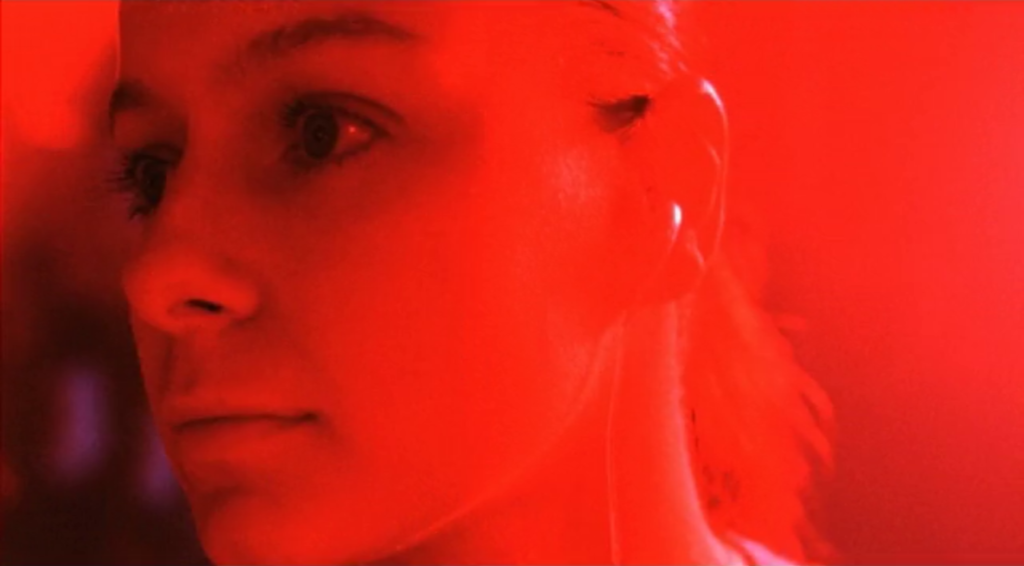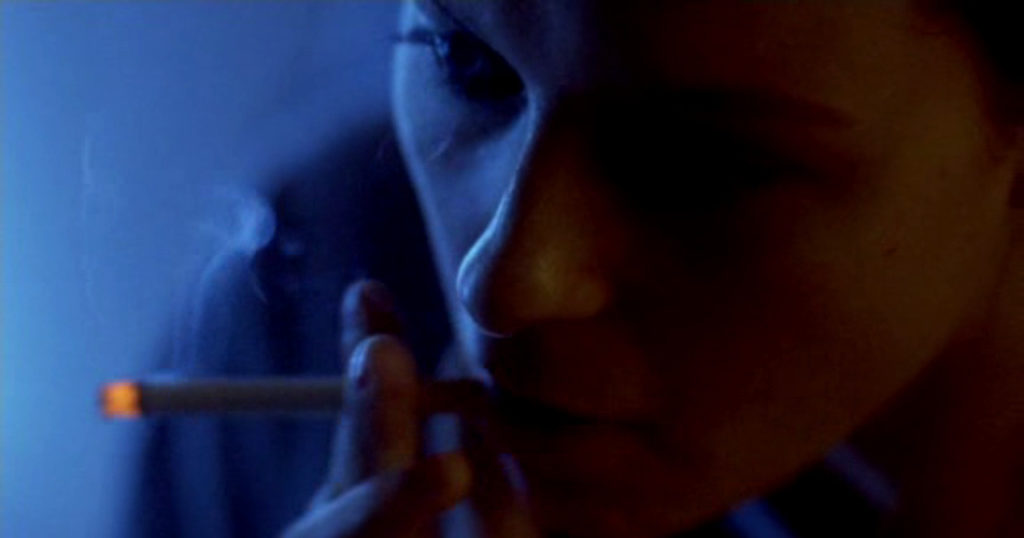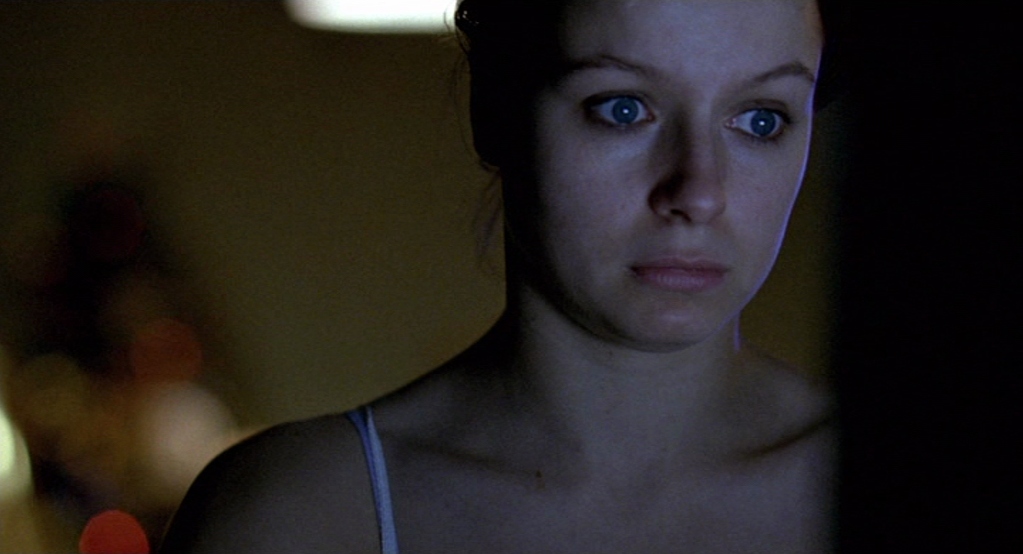| Natalie Marlin |

Morvern Callar plays at the Trylon Cinema from Friday, March 31 through Sunday, April 2. Visit trylon.org for tickets and more information.
A flashing light fades in, and the first thing we see is her face, staring out past the camera. It’s impossible to know what she’s thinking. It’s impossible to know where her focus lies, or if her eyes are merely glazing over in a kind of catatonia. Yet her eyes are the closest we can come to grasping whatever is passing through her mind in the moment—as close as one can come to understanding a stranger’s interior state through a first gaze alone.
Morvern Callar begins here, with its title character cradling her boyfriend, whom she found dead by suicide, because this moment colors every expression we read on her face. Morvern’s eyes carry the weight of this action in every moment—the trauma of discovering this death and shouldering the aftermath in solitude. And we, as viewers, only know her by this state, having never seen the person she was before this instant. To us, Morvern’s shellshocked state—deer in the headlights look and all—is all we can ever access of her.
Lynne Ramsay excels at this form of storytelling. Her protagonists often relay entire landscapes of unspoken emotional scarring in a look alone, complemented by the stellar performances she’s able to wring out of the most expressive actors around. In Ramsay’s films, the plot is a mere springboard for her actors to write entire histories into the way they cast their faces, whether it’s Tilda Swinton’s sunken eyes in We Need to Talk About Kevin or Joaquin Phoenix’s simmering stares masking profound despondency in You Were Never Really Here.

With Morvern Callar, the central performance is arguably the most haunting Ramsay has ever brought to the screen. Samantha Morton embodies the title character with a lived-in quality that infuses even the most mundane spans of the movie with intense meaning, whether in her own isolated expressions or how she performs composure around others. Though the novel the film is based on exists entirely in Morvern’s narration, Ramsay and Morton never fully let on what Morvern is thinking or feeling, even in the most pressing of circumstances. The effect is haunting—this woman’s stunned impulse to repress and prematurely move on becomes all the more impregnable to interpretation, and thereby all the more alluring.
In the sparse dialogue of Morvern Callar, Morton’s performance comes together on the visible cracks Ramsay puts on Morvern’s exterior rather than any words that leave her mouth. The British actress has a remarkably piercing gaze that Ramsay especially takes advantage of, lending her wide blue-eyed stare the inscrutable pull of the Mona Lisa smile. Ramsay’s frame compositions regularly implore the viewer to center on this feature specifically, in Morton’s bleary look at her boyfriend’s suicide note cast against a computer screen’s glow, or strobing club sequences where her eyes take on the hyper-saturation of a blacklight lamp, cutting through the crowd around her.

It’s crucial that the film starts after Morvern discovers her boyfriend’s suicide, as it’s the only true piece of context granted of her life before we enter. We arrive at the leveling out of an immensely traumatic moment for Morvern—pointedly, not at the moment of finding the body, but after whatever initial raw emotions have subsided. Like the boyfriend’s parting mixtape that provides the movie its diegetic music, his death accompanies Morvern’s every step. It is Morvern’s burden to shoulder, as the only person aware of this suicide, from the first glimpse we get of the absent gaze Morton casts for the following 90 minutes. In the film Ramsay constructs, trauma is already absorbed into the skin from the outset, soaked through as if it’s been there all along.
It’s worth noting the other major detail typifying Morvern’s perspective: that of her gender. The film only makes a single knowing nod to this element: in a meeting Morvern has with a publisher about the novel she submitted in her own name—in actuality, written by her boyfriend—she is told, “I really loved hearing such a distinctive female voice.” Though this line arrives toward the end of the film, acting mostly as a dark joke, it also works as a kind of retroactive tell about the haunted look in Morvern’s eyes.
Female trauma manifests in a complicated form all its own. Living as a traumatized woman means living with a constant awareness of how psychological damage and distress interlock with the ways we navigate the world as women. It becomes impossible to carry certain scars of trauma without being reminded of what they mean for how your body is perceived, or whether or not what you say will be taken seriously. Infrequently, Morvern tries to tell another the truth about what happened to her boyfriend. She is ignored every time. Nobody believes her, which only compounds the helplessness, the desperate silent pleas her eyes make to find any kind of solace.
To a certain type of viewer, Morvern’s actions—taking her boyfriend’s accrued funeral money, secretly disposing of his body, lying about his absence, and passing off his manuscript as her own—may read as too unsympathetic for their liking. But perhaps it’s more fitting to think about these actions by probing into the film’s uneasy questions about what a woman may do when her psyche is intensely fractured. In a state of profound trauma, what simple answers can be wrought from the intersecting breaking points placed upon all women, of grappling with a silent weight that feels insurmountable, when unyielding duress makes a woman prone to self-erosion? Even attempts at escape prove to be anything but—Morvern’s getaway to Spain marked by her eyes wandering absently, or in a piercing dissociated glare during sex.

Toward Morvern Callar’s midpoint, there comes a moment where our protagonist locks eyes with a strung-out woman pressed against the wall in a public bathroom. The woman—her eyes cast vacantly upward, too intoxicated to even pay Morvern attention—bears a not-too-dissimilar resemblance to Morvern. Morvern averts her gaze and turns away, before taking another look back and making an excuse to leave. This woman is only given one close-up, but that single shot sears, haunting in itself. None of the others in the bathroom acknowledge this woman; she takes on a presence only Morvern can recognize—a woman fully detached from the trauma buried deep in her circulation.
So much of Morvern Callar takes on this form of implicit visual storytelling—of full, unbridled trust in viewer interpretation—that seeing Morvern provides a more consistent reckoning with the scope of her trauma than any actual dialogue. There is an entire story told in Morton’s eyes, in the ways her sight can subtly adjust between dissociation and exhaustion and alert disarray from scene to scene. As the film ends without much in the way of proper resolution, it’s Morton’s eyes that become the vessel for whatever closure and certainty Ramsay provides for us. Beneath the flickering strobes of a club, Morvern gets closer and closer to the camera, only appearing in brief flashes. Her eyes are aglow once again, so our focus is naturally pulled toward them in the split-second frames where she’s visible. They look just as haunted as the last time Ramsay put her in this setting, and perhaps—Ramsay may be insinuating—they may never change. Perhaps that look in her eyes is doomed to stay, so imprinted that none of the profits Morvern gains or destination vacations she takes can ever reverse it. Morvern Callar begins with the impression that all we ever know of this woman is the rattled devastation that lies behind her every gaze; it ends as if this look may always linger with her, long after her eyes disappear into the dark of the night.
Edited by Olga Tchepikova-Treon
